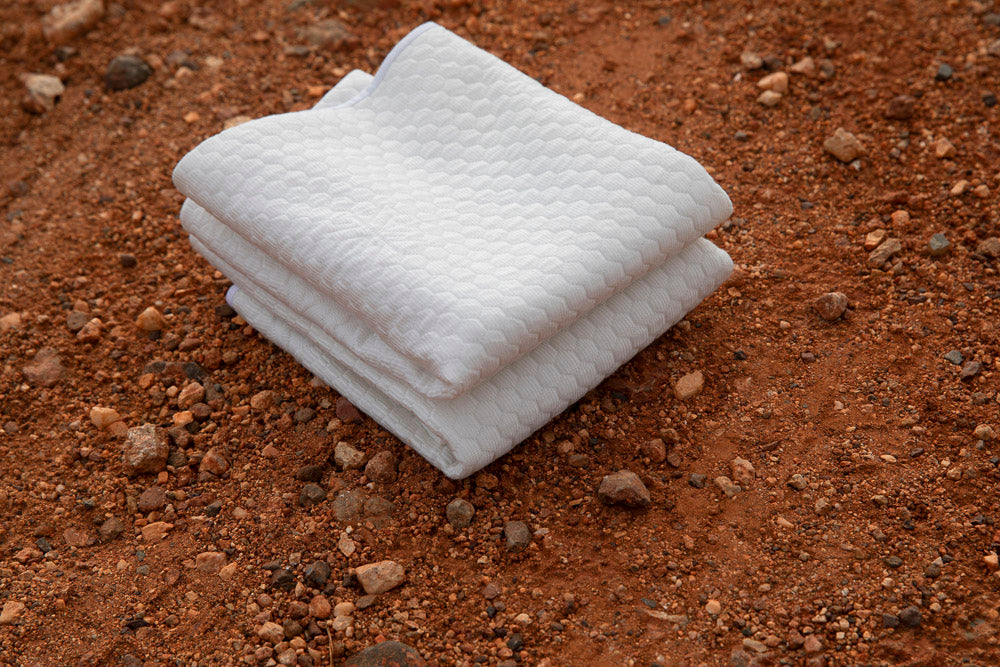The Cooling Canvas® delivers more effective cooling with less environmental impact for a uniquely cooler, drier, more comfortable experience. The Cooling Canvas® gets its unique cooling properties from polyethylene.
Polyethylene (PE) is the most sustainable among natural and synthetic textiles in the world, according to the Materials Sustainability Index. Engineering PE fibers uses less energy and water than traditional materials. They can be solution dyed and dry extruded, resulting in additional water savings.
The Cooling Canvas® employs polyethylene, a sustainable, recyclable polymer, to transfer body heat away from the skin very efficiently and Tencel, a natural fibre known for its thermoregulation properties.
A way to calculate cooling effect is to use the Qmax value (watts/m2°C). This evaluation is used to assess the surface warm / cool sensations of a fabric and indicates the instantaneous thermal feeling sensed when there is initial contact of the material with the skin surface.
The Qmax value largely depends on the contact area between skin and fabric surface. Thus, the surface characteristic of a material is important to sensations on how warm or cool a fabric feels to an individual.
A higher value of Qmax denotes that there is more rapid movement of heat from the body to the fabric surface resulting in a cooler feeling fabric. When developing options for women who are hot and who have hot flushes within their own body, and that heat is held within the body, we need to seek out the highest possible Qmax rating as this will pull the heat out of the body and into the fabric.
Having such a large surface area to do this with will increase the ability for a higher rated Qmax fabric to be effective in cooling the sleeper.
So, that was all really technical. What does that actually mean?
Think about the last time to you touched a piece of metal. Chances are, unless the metal was in direct sunlight, it felt cool to the touch. Now consider a piece of wood. Even without direct sun, the wood likely would feel room temperature. In either instance, you probably didn’t realise that you were experiencing Qmax in action.
Qmax measures how quickly the heat flows through a material upon contact. This is also known as instant cool touch.
A material’s Qmax measurement is heavily influenced by the nature of it, that is the form it’s in and the molecular arrangement within the polymer. For instance, Phenxx’s Cooling Canvas® relies on Polyethylene, a highly infrared-transparent polymer with an inherently high Qmax.
Plastic grocery bags also contain PE, but the Qmax of the Cooling Canvas® is much higher because of the contact area created when the PE yarn is made into a fabric, as well as its molecular structure. In the grocery bag, the molecules are not as well aligned as in the PE fabric, so there is less connectivity. PE’s Qmax quality is inherent, so it’s different than a finishing that you just simply coat or put on fabric. This makes the QMax of PE especially durable.
To measure Qmax, scientists use a special machine called the Thermo Labo KES-F7. The machine has two parts: a heated flat surface and a cooler block that gets placed on top. To measure a fabric’s Qmax, you put the fabric on the flat surface, cool to 25 °C and then place the block, which is heated to 35 °C (approximate skin temperature) on top. The machine will measure how quickly heat moves through the fabric to the 25 °C block.
When it comes to textiles, Qmax gives a clear measurement for the rate at which a fabric can pull your infrared body heat away from the skin, which ultimately helps you stay cooler.
It is really hard to understand a cooling rate from a number. So let's compare it to another material to gauge. Silk is one of the materials that also claims to have a good Qmax and is appropriate to compare. The Cooling Canvas® fabric rates a higher Qmax of .344 for Cooling Canvas® versus .194 for silk. A higher value of Qmax denotes that there is more rapid movement of heat from the body to the fabric surface resulting in a cooler feeling fabric.
Additionally, what the Tencel does is to keep that temperature constant thereafter. Many cooling products made solely with the PE will be cool to touch, but then heat up afterwards, meaning that you have a heat transfer into the product from the body, and then that temperature is held within the product, making it hot. So while the Qmax might be high, so too will it be hot in some time.
We combat this by using Tencel to regulate the temperature of the fabric and the sleeper. So the combination of the two means it will be cool to touch, cool you instantly and then over time it will remain cool through the natural thermoregulation properties of Tencel.
